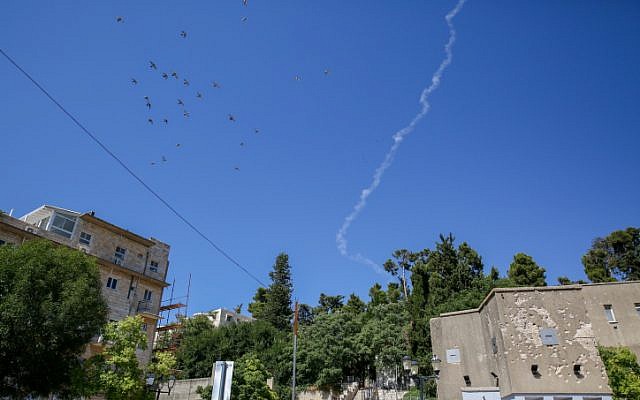In second incident in week, IDF targets UAV nearing Israeli airspace; unclear if aircraft sustains hit, who operated it

The Israel Defense Forces launched a Patriot missile at a drone approaching Israeli airspace from Syria on Friday, the second such case in under a week, the army said.
The military did not immediately confirm a hit.
It was not immediately clear if the drone entered Israeli airspace, or had only been on a trajectory to do so.
The IDF was also investigating who launched the drone. In the past, unmanned aerial vehicles flown toward Israel have been operated by Syria, Russia, Iran and the Hezbollah terrorist group, in some cases deliberately and in others apparently by accident.
The incident came two days after the military shot down a Syrian drone that penetrated several miles into Israeli territory from Syria, sending fragments of the aircraft crashing to the earth south of the Sea of Galilee. In that case, the army had waited 16 minutes before striking the drone to rule out the possibility it was operated by Russia.
According to the military, shortly after 3:15 p.m. on Wednesday an apparently unarmed Syrian drone entered Israeli airspace from Syria through the demilitarized zone between the two countries, after first passing over Jordan. Some 16 minutes later, a Patriot anti-aircraft missile was fired at the UAV, shooting it down over the Sea of Galilee, IDF spokesperson Lt. Col. Jonathan Conricus told reporters.
Hours later, in a reprisal, the Israeli Air Force carried out airstrikes in southern Syria shortly after midnight on Wednesday, targeting three regime positions in the Quneitra region near the border.
“The aircraft of the Israeli enemy launches a number of missiles at several army positions” in Quneitra, causing material damage, Syrian state news agency SANA reported.
The military later confirmed the bombings in the Syrian Golan, saying they came in response to the drone infiltration earlier in the day. The state-run outlet said the targets of the strikes were military posts near the Syrian Druze village of Hader and in the countryside west of the town of Jabah.
SANA claimed Syria’s air defenses blocked the incoming missile attack. However, video footage provided by the Israel Defense Forces (above) appeared to show the missiles hitting their three targets, causing large explosions.
That the Syrian drone was able to travel approximately 10 kilometers (6.2 miles) into Israel before being shot down on Wednesday raised questions about the military’s preparedness and ability to locate and intercept incoming aircraft.
According to the army spokesman, the delay was due to initial uncertainty over who was operating the drone, specifically if it was being flown by Russia, whose air force has been flying extensive missions over southern Syria to support dictator Bashar Assad’s offensive against two rebel-held provinces in the area.
Until the military was able to determine what steps to take against the drone, the air force called in four fighter jets and two attack helicopters, which would have been able to provide a more immediate response, Conricus said.
The Wednesday drone infiltration took place as Prime Minister Benjamin Netanyahu visited Moscow to stress to Russian President Vladimir Putin that Israel will not tolerate an Iranian military presence in Syria.
It also came days after Syria accused Israel of conducting an airstrike against the T-4 air base in central Syria, which Israeli officials have said is used as a headquarters for Iranian forces in the country.
This timing led several Israeli defense commentators to assume a connection between the events, that the infiltration was a Syrian response to the alleged Israeli airstrike.
Wednesday’s incident came just over two weeks after the IDF launched a Patriot interceptor missile at a drone that was heading toward Israeli airspace from Syria, prompting the incoming unmanned aerial vehicle to beat a retreat before it crossed the border.
In April 2017, a Syrian military drone was shot down by a Patriot missile. In September of that year, the American-made system also intercepted an unmanned aerial vehicle that was flown by the Iran-backed Hezbollah terrorist group. And in November 2017, the military shot down another Syrian military drone that approached Israeli airspace.
An Israeli official said Wednesday night Netanyahu told Putin that Israel will not seek to unseat Assad from power, while urging Moscow to remove Iranian troops from the country, according to an Israeli official.
“We won’t take action against the Assad regime, and you get the Iranians out,” Netanyahu told Putin, the Reuters news agency reported, citing an official who requested anonymity.
According to a report last month, Israel’s willingness to leave Assad in power echoes the US position.
As reported by The Times of Israel
